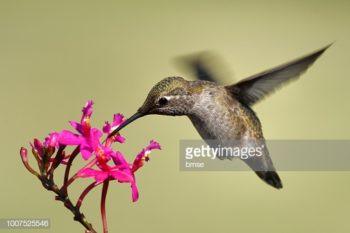Spring In Texas Means Hummingbirds Are Here

Many people call it nature’s greatest show on Earth, but it doesn’t involve elephants and a three-ring circus. Think much lighter – as in hummingbirds, which are now invading Texas.
The tiny birds that weigh no more than a handful of peanuts can cause bird lovers to go truly nutty with delight. Millions of hummingbirds, called hummers by bird enthusiasts, are starting to arrive in the state and their arrival can be a time of sheer bliss for those interested in the small birds.
Hummers frequently travel more than 1,500 miles from Central America and Mexico to get here and their route often takes them all the way to Canada.
They are considered among the most fascinating of all birds because of their at-times peculiar behavior, but don’t count on making pets out of them — as with many wild birds, it is unlawful to keep hummingbirds as pets. But they can still be admired and observed, and hummingbird feeders are a good way to do both, says Dr. Ian Tizard, a bird specialist at Texas A&M University’s College of Veterinary Medicine & Biomedical Sciences.
Tizard says the type of hummingbird you’ll see in Texas depends on where you live. East of Interstate 35, residents will most likely see the Ruby Throated hummer, while those west of I-35 will probably see the Black Chinned hummer. “Austin-area residents can see both,” he says.
In South Texas, the Buff Bellied hummingbird is common, and in West Texas the aptly named Blue Throated and Magnificent hummingbirds are seen more frequently.
Many people install hummingbird feeders to attract the birds, with several types of feeders available at hardware stores. Hummingbirds will thank you for doing so: their rapid metabolism requires them to eat constantly.
“Hummingbirds can have a wingbeat rate as high as 80 per second, although the normal rate is about 50 or so when flying,” Tizard reports. “And their heartbeat rate has been recorded as high as 1,260 beats per minute. With all of that movement, they need a lot of nourishment.”
Most hummers consume about one-half of their body weight in sugar each day, he adds.
“The substance in feeders is sugared water, and the best mix is about one cup of sugar for every four cups of water. Don’t use red dyes. They will not attract hummers and are not good for birds, and also do not use honey.”
Tizard says it’s best to space several feeders apart from each other. The reason: hummingbirds will eagerly go four or five rounds against each other for a food source.
“They are extremely territorial, especially the males,” Tizard adds.
“Hummingbirds are known for fighting among themselves for food. That’s why it’s best to have more than one feeder out. A tree is an ideal place because hummingbirds will get a drink, fly away for a few seconds, and almost surely return.”
Tizard says hummers must have solid food besides the quick sugar fix they get from feeders. Unlike other birds, they will not eat birdseed but prefer tiny insects.
“Their rapid movement requires that they eat almost constantly,” adds Tizard. “If they don’t, they can easily starve to death.”
Although hummingbirds give people a natural entertainment show, the tiny birds do have some enemies. They include owls, hawks, cats, lizards, snakes and even praying mantises and spiders.
Hummingbirds can live up to 10 years. Sizes range from 2.2 grams to the giant hummingbirds of South America, which weigh more than 20 grams and are about the size of a sparrow, Tizard adds.
But the tiny birds are pure hunks when it comes to muscle and endurance, migrating thousands of miles each year searching for flowers and food. They’ve been clocked at 30 miles per hour, but it’s suspected they can fly at least 50 mph, Tizard says.
In the air, they maneuver like no other birds – they can fly forward and backward, shift to either side and stop in mid-air. Hummers do have very weak feet and rarely walk, Tizard adds.
They have a chirping sound that is not often heard. “When they get excited, they do make chirping sounds,” Tizard explains. “But like the bird itself, it’s a tiny sound not easily heard.”
Tizard says numerous books and Web sites are available for those wanting to know more about hummingbirds, whose arrival in full force in Texas should happen during the next few weeks.





